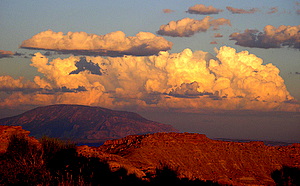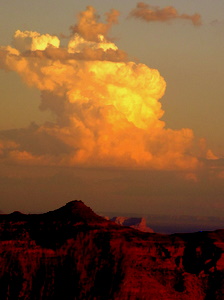I'm currently hiking and camping in New Mexico and Utah, which explains this off-topic post. I'll continue to cover big news when I'm able to access email, and will also upload and time-phase these entries for posting when I come into town for gas and supplies. To find more of this type of writing based on past trips, look to the folder link at left titled Not Here but There: A Wilderness Journal.
 Summer is the time of storms in the deserts of much of the Southwest, just as it is the time of intense heat. Except for its mountainous areas, the Southwest receives most of its meager precipitation in this way. The weather systems that form the thunderstorms of summer are thus vital to the cycle of desert life, and were they ever to fail, so, too, would most of what lives in these dry regions.
Summer is the time of storms in the deserts of much of the Southwest, just as it is the time of intense heat. Except for its mountainous areas, the Southwest receives most of its meager precipitation in this way. The weather systems that form the thunderstorms of summer are thus vital to the cycle of desert life, and were they ever to fail, so, too, would most of what lives in these dry regions.
There are two essential elements to the weather system that produces these storms. The first is the uneven heating of the desert surface by the sun, which creates variable updrafts that can rise high into the sky. And the second is a summer wind pattern that regularly carries moist air from the Gulf of Mexico into the Southwest – the technically accurate, but rather misleading name given to this element is the "Southwest Monsoon."
When desert updrafts meet this moist Gulf air, they carry it skyward into cooler altitudes, where the moisture condenses into white, decorative cumulus clouds reminiscent of cauliflowers. If the air is sufficiently moist, the clouds can grow in height, becoming "towering cumulus" clouds. And if the updraft is strong, the air more saturated with moisture, and the differential in temperature between warm updraft and cool upper air sufficiently great, then you have all of the necessary elements to create a cumulonimbus cloud - also known as a potential thunderstorm.
With the setting of the sun, the fuel source that drives such storms is gradually throttled down, as the surface of the earth radiates less and less of the heat accumulated during the day. That process is gradual enough that the storms persist into the night, but at morning, the skies are usually once again largely clear, in anticipation of repeating the cycle once again.
Thunderstorms that are formed when low and high fronts meet travel as the line of their contact progresses. But all other desert thunderstorms, like Tip O’Neil’s observation of politics, are essentially local. You can watch them as they form in the early afternoon, and hang silently in one place in the clear air, like hot air balloons on a still Arizona morning.
Earlier on this trip, I camped in the same place for the better part of a week, and watched a small storm form day after day in exactly the same place. Each day it would begin to materialize about ten miles from my own perch at the edge of a mesa. The daily storm never moved from the time it began to form until it dissipated in the night. I began to look forward to seeing its arrival at about the same time every day, and watched it form and grow until, late in the afternoon, the rain would begin. Not long thereafter, its internal energy system would reach critical mass, triggering lightning and thunder. It never became very large, and each day its rain would fall in the same, narrow curtain, at most a half-mile wide. Its presence livened up my view, which was already impressive.
Many such small storms never release a meaningful amount of precipitation at all, at least as far as the surface of the desert is concerned. When rain falls through very dry air, much, and often all, evaporates on the way down, creating the familiar, dirty curtain effect known as virga. If you see virga that reaches the ground, then the plants there are receiving at least some welcome moisture. But if the curtain ends in tatters before making contact, then the entire exercise is just a tease, full of sound and fury, but signifying nothing for the parched desert below.
When the tatters of virga hanging from a small rain cloud are twisted and slanted by wind, such a fruitless storm resembles nothing so much as an enormous, startled jellyfish, somehow transported into the sky by the puckish imagination of Douglas Adams (of Hitchhikers Guide to the Galaxy fame), and left suspended helplessly in one place.
 Desert storms, of course, can become larger, both in energy and in the amount of rain released as well as in physical size. Then, the classic anvil cloud forms and begins to consume the sky. It is the combination of the power of such a storm system with the immobility that is also characteristic that can wreak such havoc in the desert.
Desert storms, of course, can become larger, both in energy and in the amount of rain released as well as in physical size. Then, the classic anvil cloud forms and begins to consume the sky. It is the combination of the power of such a storm system with the immobility that is also characteristic that can wreak such havoc in the desert.
When this happens, the face of the landscape can change dramatically and dangerously, as vast amounts of rain – perhaps inches within an hour or two – are released over steep surfaces with little absorptive capacity. Almost all of the rain therefore runs downhill, collecting itself into juggernauts of not just water, but of rocks, mud, trees, and even boulders as large as houses that thunder their way explosively down canyons faster than they can be outrun.
Such flows sweep away everything in their path, and can re-sculpt the land in the process. When next you fly over the Southwest, look down at the enormous alluvial fans, thousands of feet deep, which extend out from the canyons below. All of that material was once a part of the mountains below you, and was carried thence by such sudden storms.
I wrote about the aftermath of one such storm here, describing how a single deluge a few years ago laid waste to most of the palm trees in a lovely Mohave Desert canyon I had visited not long before. Meanwhile, another palm canyon was untouched, though its source could be found less than a half mile from that of the canyon that had sustained devastation.
Last week I watched a large, but not catastrophic storm form at sunset, and the process was majestic. The rapidly expanding central cumulonimbus cloud was surrounded by towering cumuli that captured the light of the setting sun, at once immaculately white and illuminated from within by a borrowed, golden glow. Thin black lenses of cloud, parallel to the ground, as well as swiftly changing, equally dark scraps of raffia-like cloud, divided the bases of the illuminated clouds from their far greater parts above. And tens of thousands of feet over all, the massive, grey anvil shape of the storm cloud itself spread ever farther outward.
Soon, one part or another of the cloud system began to ignite with silent explosions of light, the storm still too far away for the thunder to reach me. But even this far away, gusts of wind began to speed past, tossing the bats around overhead like confetti that had just emerged at dusk to feed. The gusts also shook the tarp I had rigged in lean-to fashion against the rain. With time, the storm grew, and the thunder now carried, borne on increasingly powerful winds.
As the forces of those winds grew, my tarp rattled and slatted more violently, threatening to pull its grommets away and break free. I moved back further under it until my head touched, both to help support it as well as to more directly sense the power of the storm itself. Even these many miles from the tempest, that power was considerable, transmitting perhaps 30 or 40 foot-pounds of pressure down through my spine and into the earth.
For an hour or more I watched the clouds continue to grow and morph, going dead and black as the sun’s light disappeared. I heard the thunder rise and fall, pile up in response to multiple lightning strikes, and become more crisp or dull, depending on distance and wind. And I felt the gusts of wind slam into me through the tarp, as those same winds tossed the branches of the small pinyon and juniper trees around me. For hours, the storm punished the earth below with lightning, and refreshed it with rain.
But as the evening wore on into the night, the energy of the storm began to dissipate, leveling out into sustained rain and sporadic lightning. Eventually I turned in, and long into the night, stray drops of rain pattered down on the tarp overhead, enough to sooth my sleep, but not to discernibly wet the ground at this remove from the center of the storm.
In the morning, the air was fresh, and the sun brilliant. I rose to the sound of a last rumble of thunder, and the sight of a double-arched rainbow that framed the vista below, courtesy of the last drops of the vanishing storm.
 Summer is the time of storms in the deserts of much of the Southwest, just as it is the time of intense heat. Except for its mountainous areas, the Southwest receives most of its meager precipitation in this way. The weather systems that form the thunderstorms of summer are thus vital to the cycle of desert life, and were they ever to fail, so, too, would most of what lives in these dry regions.
Summer is the time of storms in the deserts of much of the Southwest, just as it is the time of intense heat. Except for its mountainous areas, the Southwest receives most of its meager precipitation in this way. The weather systems that form the thunderstorms of summer are thus vital to the cycle of desert life, and were they ever to fail, so, too, would most of what lives in these dry regions. Desert storms, of course, can become larger, both in energy and in the amount of rain released as well as in physical size. Then, the classic anvil cloud forms and begins to consume the sky. It is the combination of the power of such a storm system with the immobility that is also characteristic that can wreak such havoc in the desert.
Desert storms, of course, can become larger, both in energy and in the amount of rain released as well as in physical size. Then, the classic anvil cloud forms and begins to consume the sky. It is the combination of the power of such a storm system with the immobility that is also characteristic that can wreak such havoc in the desert.